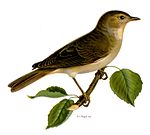Olivier Messiaen was a French composer, organist and ornithologist, one of the major composers of the 20th century. His music is rhythmically complex (he was interested in rhythms from ancient Greek and from Hindu sources); harmonically and melodically it is based on modes of limited transposition, which he abstracted from his early compositions and improvisations. Messiaen also drew on his deeply held Roman Catholicism.
He travelled widely and wrote works inspired by diverse influences such as Japanese music, the landscape of Bryce Canyon in Utah and the life of St. Francis of Assisi. He said he perceived colours when he heard certain musical chords, particularly those built from his modes (a phenomenon known as synaesthesia); combinations of these colours, he said, were important in his compositional process. For a short period Messiaen experimented with the parametrisation associated with "total serialism", in which field he is often cited as an innovator. His style absorbed many exotic musical influences such as Indonesian gamelan (tuned percussion often features prominently in his orchestral works). He was one of the first composers to use an electronic keyboard—in this case, the ondes Martenot—in an orchestral work.
Messiaen entered the Paris Conservatoire at the age of 11 and was taught by Paul Dukas, Maurice Emmanuel, Charles-Marie Widor and Marcel Dupré, among others. He was appointed organist at the Église de la Sainte-Trinité in Paris in 1931, a post held until his death. He taught at the Schola Cantorum de Paris during the 1930s. On the fall of France in 1940, Messiaen was made a prisoner of war, during which time he composed his Quatuor pour la fin du temps ("Quartet for the end of time") for the four available instruments—piano, violin, cello and clarinet. The piece was first performed by Messiaen and fellow prisoners for an audience of inmates and prison guards. He was appointed professor of harmony soon after his release in 1941, and professor of composition in 1966 at the Paris Conservatoire, positions he held until his retirement in 1978. His many distinguished pupils included Pierre Boulez and Yvonne Loriod, who became his second wife.
He found birdsong fascinating, believed birds to be the greatest musicians, and considered himself as much an ornithologist as a composer. He notated bird songs worldwide and incorporated birdsong transcriptions into most of his music. His innovative use of colour, his conception of the relationship between time and music, and his use of birdsong are among features that make Messiaen's music distinctive.
Birdsong and the 1960s
When in 1952 Messiaen was asked to provide a test piece for flautists wishing to enter the Paris Conservatoire, he composed the piece Le merle noir for flute and piano. While he had long been fascinated by birdsong, and birds had made appearances in several of his earlier works (for example La Nativité, Quatuor and Vingt regards), the flute piece was based entirely on the song of the blackbird.He took this development to a new level with his 1953 orchestral work Réveil des oiseaux—its material consists almost entirely of the birdsong one might hear between midnight and noon in the Jura. From this period onwards, Messiaen incorporated birdsong into all of his compositions and composed several works for which birds provide both the title and subject matter (for example the collection of thirteen pieces for piano Catalogue d'oiseaux completed in 1958, and La fauvette des jardins of 1971). Far from being simple transcriptions of birdsong, these works are sophisticated tone poems evoking both place and atmosphere. Paul Griffiths observed that Messiaen was a more conscientious ornithologist than any previous composer, and a more musical observer of birdsong than any previous ornithologist.

The Garden Warbler provided the title and much of the material for Messiaen's La fauvette des jardins.
Messiaen's music was by this time championed by, among others, Pierre Boulez, who programmed first performances at his Domaine musical concerts and the Donaueschingen festival. Works performed included Réveil des oiseaux, Chronochromie (commissioned for the 1960 festival) and Couleurs de la cité céleste. The latter piece was the result of a commission for a composition for three trombones and three xylophones; Messiaen added to this more brass, wind, percussion and piano, and specified a xylophone, xylorimba and marimba rather than three xylophones. Another work of this period, Et exspecto resurrectionem mortuorum, was commissioned as a commemoration of the dead of the two World Wars and was performed first semi-privately in the Sainte-Chapelle, then publicly in Chartres Cathedral with Charles de Gaulle in the audience.
His reputation as a composer continued to grow and in 1959, he was nominated as an Officier of the Légion d'honneur. In 1966 he was officially appointed professor of composition at the Paris Conservatoire, although he had in effect been teaching composition for years. Further honours included election to the Institut de France in 1967, the Erasmus Prize in 1971, the award of the Royal Philharmonic Society Gold Medal and the Ernst von Siemens Music Prize in 1975, the Sonning Award (Denmark's highest musical honour) in 1977, and the presentation of the Croix de Commander of the Belgian Order of the Crown in 1980.

